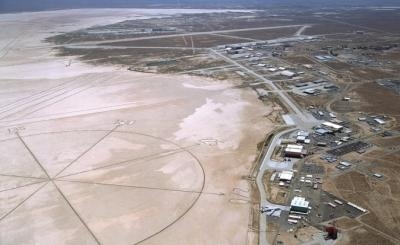Follows Unanimous Passage Of Congressional Resolution Supporting The Change
Two generations of aerospace engineering excellence came together Saturday, March 1 when NASA's Dryden Flight Research Center in Edwards, CA was redesignated NASA's Armstrong Flight Research Center.

The agency's center of excellence for atmospheric flight research is being renamed in honor of the late Neil A. Armstrong, a former research test pilot at the center and the first man to step on the moon during the historic Apollo 11 mission in 1969. The late Hugh L. Dryden, the center's namesake since 1976, will continue to be memorialized in the renaming of the center's 12,000-square-mile Western Aeronautical Test Range as the Dryden Aeronautical Test Range.
"I cannot think of a more appropriate way to honor these two leaders who broadened our understanding of aeronautics and space exploration," said NASA Administrator Charles Bolden. "Both Dryden and Armstrong are pioneers whose contributions to NASA and our nation still resonate today. Armstrong was the first person to walk on the moon. Dryden's expertise at the National Advisory Committee for Aeronautics and then at NASA established America's leadership in aerospace, and his vision paved the way for Armstrong to take those first steps."
The redesignation of the center, which is located on Edwards Air Force Base in Southern California, was directed in legislation authored by Rep. Kevin McCarthy of California's 22nd district. The resolution was passed unanimously by the U.S. House of Representatives in early 2013, with the Senate concurring in early January, followed by President Obama's signing it into law Jan. 16.
Armstrong had significant ties to the center, both before and after his days as a NASA astronaut. He served as a research test pilot at the center from 1955 to 1962, amassing more than 2,400 flight hours in 48 different models of aircraft at the center, including seven flights in the rocket-powered hypersonic X-15. Armstrong was part of a team that conceptualized the Lunar Landing Research Vehicle, a flight test craft that evolved into the Lunar Landing Training Vehicle. Armstrong and the other commanders of Apollo lunar landing missions trained in that vehicle for their descents from lunar orbit down to the surface of the moon.

Following Apollo 11, Armstrong left the astronaut corps and became NASA's Deputy Associate Administrator for Aeronautics, overseeing aeronautical research programs being conducted at the center, particularly its pioneering work on developing digital electronic flight control systems.
Dryden, considered an aeronautical engineering genius, focused on high-speed flight during his tenure as an aeronautical scientist with the National Bureau of Standards. Involved in NACA research from his doctoral research days, Dryden's first NACA Technical Report was published in 1924 and after World War II he moved from the Bureau of Standards to take charge of the NACA in 1947. Under his deft leadership, the NACA rapidly pushed the boundaries of high speed flight and organized the research that led to our first steps into space. Dryden continued with the agency after NACA became NASA in late 1958, serving as deputy administrator of NASA until his death in 1965.
Dryden's quiet, but visionary leadership of the NACA is what prepared that organization to become NASA in 1958, and to have an achievable plan for a human expedition to the moon when President John F. Kennedy called for it in 1961. The organizational genius of Dryden was at the root of Armstrong's most spectacular flight achievements, from the X-15 to Tranquility Base.
The renaming of a NASA center is not without precedent. In 1999, the Lewis Research Center in Cleveland was renamed in honor of Sen. John Glenn, the first American to orbit the Earth in the Friendship 7 Mercury capsule in 1962.
A formal public ceremony to mark the redesignation of the center and its test range is planned for this spring.
(Images provided by NASA)
 ANN's Daily Aero-Term (04.26.24): DETRESFA (Distress Phrase)
ANN's Daily Aero-Term (04.26.24): DETRESFA (Distress Phrase) ANN's Daily Aero-Linx (04.26.24)
ANN's Daily Aero-Linx (04.26.24) Airborne 04.22.24: Rotor X Worsens, Airport Fees 4 FNB?, USMC Drone Pilot
Airborne 04.22.24: Rotor X Worsens, Airport Fees 4 FNB?, USMC Drone Pilot Airborne 04.24.24: INTEGRAL E, Elixir USA, M700 RVSM
Airborne 04.24.24: INTEGRAL E, Elixir USA, M700 RVSM Airborne-NextGen 04.23.24: UAVOS UVH 170, magni650 Engine, World eVTOL Directory
Airborne-NextGen 04.23.24: UAVOS UVH 170, magni650 Engine, World eVTOL Directory




